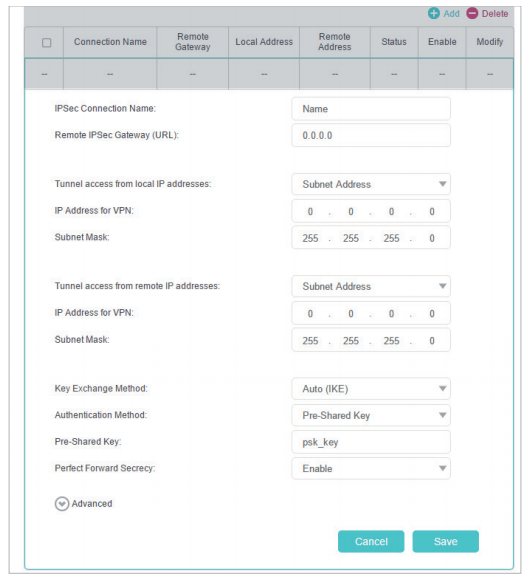How to configure IPSec VPN on 3G/4G Wireless Router TL-MR3420 (new logo)
TL-MR3420( V5 )
Recent updates may have expanded access to feature(s) discussed in this FAQ. Visit your product's support page, select the correct hardware version for your device, and check either the Datasheet or the firmware section for the latest improvements added to your product. Please note that product availability varies by region, and certain models may not be available in your region.
With IPSec VPN, you can access the network securely when out of home. To use the VPN Service, you need to configure Dynamic DNS Service or assign a static IP address for the router’s WAN port. And the System Time should be synchronized with the internet.
Note: TL-MR3420_V5 is used for demonstration in this article.
1. Visit http://tplinkwifi.net, and log in with the password you set for the router. For details, please refer to How to log in to the web-based interface of Wi-Fi Routers (new logo)?
2. Go to Advanced > VPN > IPSec VPN.
3. Enable Dead Peer Detection.

4. Click Add and enter correspond parameters.

• IPSec Connection Name: Enter a name for the IPSec VPN connection.
• Remote IPSec Gateway (URL): Enter the destination gateway IP address which is the public WAN IP or domain name of the remote VPN server endpoint.
• Tunnel access from local IP addresses: Select Subnet Address if you want the whole LAN to join the VPN network, or select Single Address if you want a single IP to join the VPN network.
• IP Address for VPN: Enter the IP address of your LAN.
• Subnet Mask: Enter the subnet mask of your LAN.
• Tunnel access from remote IP addresses: Select Subnet Address if you want the whole remote LAN to join the VPN network, or select Single Address if you want a single IP to join the VPN network.
• IP Address for VPN: Enter the IP address of the remote LAN.
• IP Subnet Mask: Enter the subnet mask of the remote LAN.
• Key Exchange Method: Select Auto (IKE) or Manual to be used to authenticate IPSec peers.
• Authentication Method: Select Pre-Shared Key (recommended).
• Pre-Shared Key: Create a pre-shared key to be used for authentication.
• Perfect Forward Secrecy: Select Enable or Disable as an additional security protocol for the pre-shared key.
You can configure the advanced settings as needed. It’s recommended to keep the default values. If you want to change these settings, make sure that both VPN server endpoints use the same Encryption Algorithm, Integrity Algorithm, Diffie-Hellman Group and Key Lifetime in both phase1 and phase2.
5. Click Save.
Get to know more details of each function and configuration please go to Download Center to download the manual of your product.
Esta FAQ é útil?
Seu feedback ajuda a melhorar este site.
Qual é a sua preocupação com este artigo?
- Insatisfeito com o produto
- Muito complicado
- Título confuso
- Não se aplica a mim
- Muito vago
- Outros
Obrigado, senhor
Agradecemos o seu feedback.
Clique aqui para contatar nosso Suporte Técnico.
Recommend Products
Este site usa cookies. Ao continuar a navegar no site, você concorda com o uso de cookies. Não mostrar novamente Saiba mais .
Este site usa cookies. Ao continuar a navegar no site, você concorda com o uso de cookies. Não mostrar novamente Saiba mais .
Cookies básicos
Esses cookies são necessários para o funcionamento do site e não podem ser desativados em seus sistemas.
TP-Link
accepted_local_switcher, tp_privacy_base, tp_privacy_marketing, tp_smb-select-product_scence, tp_smb-select-product_scenceSimple, tp_smb-select-product_userChoice, tp_smb-select-product_userChoiceSimple, tp_smb-select-product_userInfo, tp_smb-select-product_userInfoSimple, tp_top-banner, tp_popup-bottom, tp_popup-center, tp_popup-right-middle, tp_popup-right-bottom, tp_productCategoryType
Livechat
__livechat, __lc2_cid, __lc2_cst, __lc_cid, __lc_cst, CASID
Youtube
id, VISITOR_INFO1_LIVE, LOGIN_INFO, SIDCC, SAPISID, APISID, SSID, SID, YSC, __Secure-1PSID, __Secure-1PAPISID, __Secure-1PSIDCC, __Secure-3PSID, __Secure-3PAPISID, __Secure-3PSIDCC, 1P_JAR, AEC, NID, OTZ
Cookies de Marketing e Análise
Os cookies de análise nos permitem analisar suas atividades em nosso site para melhorar e adaptar a funcionalidade do mesmo.
Os cookies de marketing podem ser definidos por meio de nosso site por nossos parceiros publicitários para criar um perfil de seus interesses e exibir anúncios relevantes em outros sites.
Google Analytics & Google Tag Manager
_gid, _ga_<container-id>, _ga, _gat_gtag_<container-id>
Google Ads & DoubleClick
test_cookie, _gcl_au
Meta Pixel
_fbp
Crazy Egg
cebsp_, _ce.s, _ce.clock_data, _ce.clock_event, cebs
lidc, AnalyticsSyncHistory, UserMatchHistory, bcookie, li_sugr, ln_or
TikTok
_ttp
